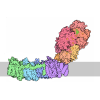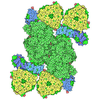[English] 日本語
 Yorodumi
Yorodumi- PDB-6zvj: Structure of a human ABCE1-bound 43S pre-initiation complex - State II -
+ Open data
Open data
- Basic information
Basic information
| Entry | Database: PDB / ID: 6zvj | |||||||||
|---|---|---|---|---|---|---|---|---|---|---|
| Title | Structure of a human ABCE1-bound 43S pre-initiation complex - State II | |||||||||
 Components Components |
| |||||||||
 Keywords Keywords | RIBOSOME / Translation / Initiation / Ribosome Recycling / ABC Proteins | |||||||||
| Function / homology |  Function and homology information Function and homology informationnegative regulation of endoribonuclease activity / CTPase activity / positive regulation of mRNA binding / viral translational termination-reinitiation / eukaryotic translation initiation factor 3 complex, eIF3e / cap-dependent translational initiation / eukaryotic translation initiation factor 3 complex, eIF3m / IRES-dependent viral translational initiation / translation reinitiation / OAS antiviral response ...negative regulation of endoribonuclease activity / CTPase activity / positive regulation of mRNA binding / viral translational termination-reinitiation / eukaryotic translation initiation factor 3 complex, eIF3e / cap-dependent translational initiation / eukaryotic translation initiation factor 3 complex, eIF3m / IRES-dependent viral translational initiation / translation reinitiation / OAS antiviral response / formation of cytoplasmic translation initiation complex / eukaryotic translation initiation factor 3 complex / multi-eIF complex / cytoplasmic translational initiation / translation factor activity, RNA binding / eukaryotic 43S preinitiation complex / mRNA cap binding / eukaryotic 48S preinitiation complex / ribosomal subunit / negative regulation of endoplasmic reticulum unfolded protein response / oxidized pyrimidine DNA binding / response to TNF agonist / positive regulation of base-excision repair / positive regulation of respiratory burst involved in inflammatory response / positive regulation of intrinsic apoptotic signaling pathway in response to DNA damage / positive regulation of gastrulation / protein tyrosine kinase inhibitor activity / positive regulation of endodeoxyribonuclease activity / IRE1-RACK1-PP2A complex / nucleolus organization / positive regulation of Golgi to plasma membrane protein transport / ribosome disassembly / TNFR1-mediated ceramide production / negative regulation of DNA repair / negative regulation of RNA splicing / metal-dependent deubiquitinase activity / nuclear-transcribed mRNA catabolic process, nonsense-mediated decay / supercoiled DNA binding / neural crest cell differentiation / regulation of translational initiation / NF-kappaB complex / cysteine-type endopeptidase activator activity involved in apoptotic process / oxidized purine DNA binding / positive regulation of ubiquitin-protein transferase activity / negative regulation of intrinsic apoptotic signaling pathway in response to hydrogen peroxide / regulation of establishment of cell polarity / negative regulation of bicellular tight junction assembly / ubiquitin-like protein conjugating enzyme binding / negative regulation of phagocytosis / rRNA modification in the nucleus and cytosol / erythrocyte homeostasis / Formation of the ternary complex, and subsequently, the 43S complex / cytoplasmic side of rough endoplasmic reticulum membrane / laminin receptor activity / negative regulation of ubiquitin protein ligase activity / protein kinase A binding / ion channel inhibitor activity / Ribosomal scanning and start codon recognition / pigmentation / Translation initiation complex formation / positive regulation of mitochondrial depolarization / positive regulation of T cell receptor signaling pathway / fibroblast growth factor binding / negative regulation of Wnt signaling pathway / monocyte chemotaxis / positive regulation of activated T cell proliferation / negative regulation of translational frameshifting / TOR signaling / Protein hydroxylation / BH3 domain binding / SARS-CoV-1 modulates host translation machinery / iron-sulfur cluster binding / regulation of adenylate cyclase-activating G protein-coupled receptor signaling pathway / regulation of cell division / cellular response to ethanol / mTORC1-mediated signalling / Peptide chain elongation / ribosomal small subunit binding / Selenocysteine synthesis / Formation of a pool of free 40S subunits / positive regulation of intrinsic apoptotic signaling pathway by p53 class mediator / endonucleolytic cleavage to generate mature 3'-end of SSU-rRNA from (SSU-rRNA, 5.8S rRNA, LSU-rRNA) / Eukaryotic Translation Termination / ubiquitin ligase inhibitor activity / positive regulation of GTPase activity / SRP-dependent cotranslational protein targeting to membrane / Response of EIF2AK4 (GCN2) to amino acid deficiency / protein serine/threonine kinase inhibitor activity / negative regulation of ubiquitin-dependent protein catabolic process / positive regulation of signal transduction by p53 class mediator / Viral mRNA Translation / negative regulation of respiratory burst involved in inflammatory response / Nonsense Mediated Decay (NMD) independent of the Exon Junction Complex (EJC) / GTP hydrolysis and joining of the 60S ribosomal subunit / L13a-mediated translational silencing of Ceruloplasmin expression / Major pathway of rRNA processing in the nucleolus and cytosol / endoribonuclease inhibitor activity / phagocytic cup / regulation of translational fidelity / translational termination Similarity search - Function | |||||||||
| Biological species |  Homo sapiens (human) Homo sapiens (human) | |||||||||
| Method | ELECTRON MICROSCOPY / single particle reconstruction / cryo EM / Resolution: 3.8 Å | |||||||||
 Authors Authors | Kratzat, H. / Mackens-Kiani, T. / Ameismeier, A. / Cheng, J. / Berninghausen, O. / Becker, T. / Beckmann, R. | |||||||||
| Funding support |  Germany, Germany,  France, 2items France, 2items
| |||||||||
 Citation Citation |  Journal: EMBO J / Year: 2021 Journal: EMBO J / Year: 2021Title: A structural inventory of native ribosomal ABCE1-43S pre-initiation complexes. Authors: Hanna Kratzat / Timur Mackens-Kiani / Michael Ameismeier / Mia Potocnjak / Jingdong Cheng / Estelle Dacheux / Abdelkader Namane / Otto Berninghausen / Franz Herzog / Micheline Fromont-Racine ...Authors: Hanna Kratzat / Timur Mackens-Kiani / Michael Ameismeier / Mia Potocnjak / Jingdong Cheng / Estelle Dacheux / Abdelkader Namane / Otto Berninghausen / Franz Herzog / Micheline Fromont-Racine / Thomas Becker / Roland Beckmann /   Abstract: In eukaryotic translation, termination and ribosome recycling phases are linked to subsequent initiation of a new round of translation by persistence of several factors at ribosomal sub-complexes. ...In eukaryotic translation, termination and ribosome recycling phases are linked to subsequent initiation of a new round of translation by persistence of several factors at ribosomal sub-complexes. These comprise/include the large eIF3 complex, eIF3j (Hcr1 in yeast) and the ATP-binding cassette protein ABCE1 (Rli1 in yeast). The ATPase is mainly active as a recycling factor, but it can remain bound to the dissociated 40S subunit until formation of the next 43S pre-initiation complexes. However, its functional role and native architectural context remains largely enigmatic. Here, we present an architectural inventory of native yeast and human ABCE1-containing pre-initiation complexes by cryo-EM. We found that ABCE1 was mostly associated with early 43S, but also with later 48S phases of initiation. It adopted a novel hybrid conformation of its nucleotide-binding domains, while interacting with the N-terminus of eIF3j. Further, eIF3j occupied the mRNA entry channel via its ultimate C-terminus providing a structural explanation for its antagonistic role with respect to mRNA binding. Overall, the native human samples provide a near-complete molecular picture of the architecture and sophisticated interaction network of the 43S-bound eIF3 complex and the eIF2 ternary complex containing the initiator tRNA. | |||||||||
| History |
|
- Structure visualization
Structure visualization
| Movie |
 Movie viewer Movie viewer |
|---|---|
| Structure viewer | Molecule:  Molmil Molmil Jmol/JSmol Jmol/JSmol |
- Downloads & links
Downloads & links
- Download
Download
| PDBx/mmCIF format |  6zvj.cif.gz 6zvj.cif.gz | 2.6 MB | Display |  PDBx/mmCIF format PDBx/mmCIF format |
|---|---|---|---|---|
| PDB format |  pdb6zvj.ent.gz pdb6zvj.ent.gz | Display |  PDB format PDB format | |
| PDBx/mmJSON format |  6zvj.json.gz 6zvj.json.gz | Tree view |  PDBx/mmJSON format PDBx/mmJSON format | |
| Others |  Other downloads Other downloads |
-Validation report
| Summary document |  6zvj_validation.pdf.gz 6zvj_validation.pdf.gz | 1.7 MB | Display |  wwPDB validaton report wwPDB validaton report |
|---|---|---|---|---|
| Full document |  6zvj_full_validation.pdf.gz 6zvj_full_validation.pdf.gz | 1.8 MB | Display | |
| Data in XML |  6zvj_validation.xml.gz 6zvj_validation.xml.gz | 266 KB | Display | |
| Data in CIF |  6zvj_validation.cif.gz 6zvj_validation.cif.gz | 447.7 KB | Display | |
| Arichive directory |  https://data.pdbj.org/pub/pdb/validation_reports/zv/6zvj https://data.pdbj.org/pub/pdb/validation_reports/zv/6zvj ftp://data.pdbj.org/pub/pdb/validation_reports/zv/6zvj ftp://data.pdbj.org/pub/pdb/validation_reports/zv/6zvj | HTTPS FTP |
-Related structure data
| Related structure data |  11458MC  6zceC  6zu9C  7a09C  7a1gC C: citing same article ( M: map data used to model this data |
|---|---|
| Similar structure data |
- Links
Links
- Assembly
Assembly
| Deposited unit | 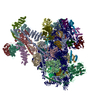
|
|---|---|
| 1 |
|
- Components
Components
+40S ribosomal protein ... , 31 types, 31 molecules apdQqrstcnmiyfjzRTwgbeuvokxhPSl
-Protein , 5 types, 5 molecules UV1NY
| #34: Protein | Mass: 7257.627 Da / Num. of mol.: 1 / Source method: isolated from a natural source / Source: (natural)  Homo sapiens (human) / References: UniProt: P62979 Homo sapiens (human) / References: UniProt: P62979 |
|---|---|
| #35: Protein | Mass: 34224.641 Da / Num. of mol.: 1 / Source method: isolated from a natural source / Source: (natural)  Homo sapiens (human) / References: UniProt: P63244 Homo sapiens (human) / References: UniProt: P63244 |
| #46: Protein | Mass: 66972.789 Da / Num. of mol.: 1 / Source method: isolated from a natural source / Source: (natural)  Homo sapiens (human) / References: UniProt: P61221 Homo sapiens (human) / References: UniProt: P61221 |
| #47: Protein | Mass: 10388.935 Da / Num. of mol.: 1 / Source method: isolated from a natural source / Source: (natural)  Homo sapiens (human) / References: UniProt: P41567 Homo sapiens (human) / References: UniProt: P41567 |
| #49: Protein | Mass: 5562.077 Da / Num. of mol.: 1 / Source method: isolated from a natural source / Source: (natural)  Homo sapiens (human) Homo sapiens (human) |
-Eukaryotic translation initiation factor 3 subunit ... , 12 types, 13 molecules IBACEFHKLMDGJ
| #36: Protein | Mass: 35352.535 Da / Num. of mol.: 1 / Source method: isolated from a natural source / Source: (natural)  Homo sapiens (human) / References: UniProt: Q13347 Homo sapiens (human) / References: UniProt: Q13347 |
|---|---|
| #37: Protein | Mass: 65901.969 Da / Num. of mol.: 1 / Source method: isolated from a natural source / Source: (natural)  Homo sapiens (human) / References: UniProt: P55884 Homo sapiens (human) / References: UniProt: P55884 |
| #38: Protein | Mass: 85564.188 Da / Num. of mol.: 1 / Source method: isolated from a natural source / Source: (natural)  Homo sapiens (human) / References: UniProt: Q14152 Homo sapiens (human) / References: UniProt: Q14152 |
| #39: Protein | Mass: 86197.570 Da / Num. of mol.: 1 / Source method: isolated from a natural source / Source: (natural)  Homo sapiens (human) / References: UniProt: B4DVU3 Homo sapiens (human) / References: UniProt: B4DVU3 |
| #40: Protein | Mass: 50438.680 Da / Num. of mol.: 1 / Source method: isolated from a natural source / Source: (natural)  Homo sapiens (human) / References: UniProt: P60228 Homo sapiens (human) / References: UniProt: P60228 |
| #41: Protein | Mass: 29836.004 Da / Num. of mol.: 1 / Source method: isolated from a natural source / Source: (natural)  Homo sapiens (human) / References: UniProt: O00303, ubiquitinyl hydrolase 1 Homo sapiens (human) / References: UniProt: O00303, ubiquitinyl hydrolase 1 |
| #42: Protein | Mass: 36960.078 Da / Num. of mol.: 1 / Source method: isolated from a natural source / Source: (natural)  Homo sapiens (human) / References: UniProt: O15372 Homo sapiens (human) / References: UniProt: O15372 |
| #43: Protein | Mass: 24952.424 Da / Num. of mol.: 1 / Source method: isolated from a natural source / Source: (natural)  Homo sapiens (human) / References: UniProt: Q9UBQ5 Homo sapiens (human) / References: UniProt: Q9UBQ5 |
| #44: Protein | Mass: 44172.688 Da / Num. of mol.: 1 / Source method: isolated from a natural source / Source: (natural)  Homo sapiens (human) / References: UniProt: Q9Y262 Homo sapiens (human) / References: UniProt: Q9Y262 |
| #45: Protein | Mass: 41278.391 Da / Num. of mol.: 1 / Source method: isolated from a natural source / Source: (natural)  Homo sapiens (human) / References: UniProt: Q7L2H7 Homo sapiens (human) / References: UniProt: Q7L2H7 |
| #48: Protein | Mass: 61489.441 Da / Num. of mol.: 1 / Source method: isolated from a natural source / Source: (natural)  Homo sapiens (human) / References: UniProt: O15371 Homo sapiens (human) / References: UniProt: O15371 |
| #50: Protein | Mass: 29108.453 Da / Num. of mol.: 2 / Source method: isolated from a natural source / Source: (natural)  Homo sapiens (human) / References: UniProt: O75822 Homo sapiens (human) / References: UniProt: O75822 |
-Protein/peptide / RNA chain , 2 types, 2 molecules W2
| #20: RNA chain | Mass: 555210.688 Da / Num. of mol.: 1 / Source method: isolated from a natural source / Source: (natural)  Homo sapiens (human) Homo sapiens (human) |
|---|---|
| #6: Protein/peptide | Mass: 3344.271 Da / Num. of mol.: 1 / Source method: isolated from a natural source / Source: (natural)  Homo sapiens (human) / References: UniProt: P62945 Homo sapiens (human) / References: UniProt: P62945 |
-Non-polymers , 5 types, 9 molecules 
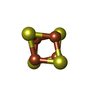







| #51: Chemical | | #52: Chemical | #53: Chemical | ChemComp-ADP / | #54: Chemical | #55: Chemical | ChemComp-ATP / | |
|---|
-Details
| Has ligand of interest | N |
|---|
-Experimental details
-Experiment
| Experiment | Method: ELECTRON MICROSCOPY |
|---|---|
| EM experiment | Aggregation state: PARTICLE / 3D reconstruction method: single particle reconstruction |
- Sample preparation
Sample preparation
| Component | Name: ABCE1-bound 43S initiation complex / Type: RIBOSOME / Entity ID: #1-#50 / Source: NATURAL |
|---|---|
| Source (natural) | Organism:  Homo sapiens (human) Homo sapiens (human) |
| Buffer solution | pH: 7.6 |
| Specimen | Embedding applied: NO / Shadowing applied: NO / Staining applied: NO / Vitrification applied: YES |
| Vitrification | Cryogen name: ETHANE |
- Electron microscopy imaging
Electron microscopy imaging
| Experimental equipment |  Model: Titan Krios / Image courtesy: FEI Company |
|---|---|
| Microscopy | Model: FEI TITAN KRIOS |
| Electron gun | Electron source:  FIELD EMISSION GUN / Accelerating voltage: 300 kV / Illumination mode: FLOOD BEAM FIELD EMISSION GUN / Accelerating voltage: 300 kV / Illumination mode: FLOOD BEAM |
| Electron lens | Mode: BRIGHT FIELD |
| Image recording | Electron dose: 48 e/Å2 / Film or detector model: GATAN K2 QUANTUM (4k x 4k) |
- Processing
Processing
| CTF correction | Type: PHASE FLIPPING AND AMPLITUDE CORRECTION | ||||||||||||||||||||||||
|---|---|---|---|---|---|---|---|---|---|---|---|---|---|---|---|---|---|---|---|---|---|---|---|---|---|
| 3D reconstruction | Resolution: 3.8 Å / Resolution method: FSC 0.143 CUT-OFF / Num. of particles: 5231 / Symmetry type: POINT | ||||||||||||||||||||||||
| Refinement | Stereochemistry target values: GeoStd + Monomer Library + CDL v1.2 | ||||||||||||||||||||||||
| Displacement parameters | Biso mean: 19.98 Å2 | ||||||||||||||||||||||||
| Refine LS restraints |
|
 Movie
Movie Controller
Controller








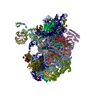
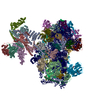




 PDBj
PDBj
































